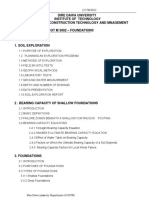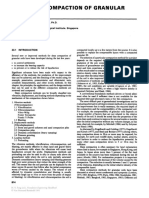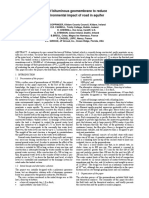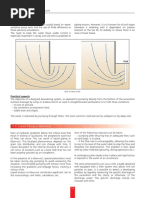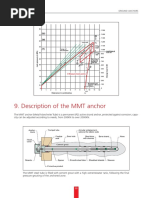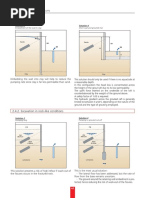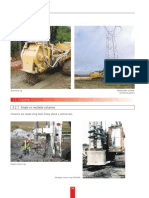Diaphragm Walls and Stractures 55
Diaphragm Walls and Stractures 55
Uploaded by
jaga67Copyright:
Available Formats
Diaphragm Walls and Stractures 55
Diaphragm Walls and Stractures 55
Uploaded by
jaga67Original Description:
Copyright
Available Formats
Share this document
Did you find this document useful?
Is this content inappropriate?
Copyright:
Available Formats
Diaphragm Walls and Stractures 55
Diaphragm Walls and Stractures 55
Uploaded by
jaga67Copyright:
Available Formats
GROUND WATER LOWERING - CUT-OFFS
2.3. Defining the Dewatering Project
From the technical options available, the choice will be These choices must take into account the risks described
made by reference to the following factors: in Paragraph 3 and be used to determine the require-
- the hydrology, ments in terms of:
- the geometry of the works, - possible cut-offs: walls, grouting,
- the external environment, - pumping installation (wells, wellpoints, etc.) and
- the contractual framework (e.g. maximum discharge monitoring devices (piezometers),
rate). (Refer to the tables at end of Paragraph 4, indicating the
scope of the different methods).
2.4. Examples of approaches for deep, retained excavations
We give below options that can be adopted to control ground water during bulk excavation in different ground
conditions for deep retained excavations:
- in sandy soils,
- in rocky-like conditions,
- in competent soil with a more permeable soil stratum at depth.
2.4.1. Excavation in sandy soils
Solution 1 Solution 2
Short wall and pumping Extending the wall downwards
This solution is possible: The deepening of the wall increases the head loss:
- if the discharge rate is environmentally acceptable, Q2 < Q1
- if the ground water can be effectively extracted
(extremely difficult for silts and very fine sands), Note: this deepening of the wall can be replaced by a
- if the external drawdown, Re, is permissible. grouted cut-off.
67
You might also like
- An Introduction To Rigid Pavement DesignDocument24 pagesAn Introduction To Rigid Pavement DesignSheikh Nouman Mohsin Ramzi100% (1)
- Engineer's Report: Seismic Performance Evaluation and Tire Construction AnalysisFrom EverandEngineer's Report: Seismic Performance Evaluation and Tire Construction AnalysisNo ratings yet
- Principles of Irrigation Engineering – Arid Lands, Water Supply, Storage Works, Dams, Canals, Water Rights and ProductsFrom EverandPrinciples of Irrigation Engineering – Arid Lands, Water Supply, Storage Works, Dams, Canals, Water Rights and ProductsNo ratings yet
- Foundation Lecture Notes 1Document5 pagesFoundation Lecture Notes 1Dianne Abigail CatliNo ratings yet
- Explain ExcavationDocument19 pagesExplain ExcavationTAWDE KOMAL100% (1)
- Comparison Between Stone Columns and Vertical Geodrains With Preloading Embankment TechniquesDocument13 pagesComparison Between Stone Columns and Vertical Geodrains With Preloading Embankment TechniquesJuan Camilo PinedaNo ratings yet
- NBC 2005 Soil 382,383Document2 pagesNBC 2005 Soil 382,383suresh84123No ratings yet
- Recommendations For SC PDFDocument15 pagesRecommendations For SC PDFPau VallsNo ratings yet
- 4 - Ponds Fountains - RPF5 Firestone Pond Lining Installation GuideDocument79 pages4 - Ponds Fountains - RPF5 Firestone Pond Lining Installation Guidedan ivanNo ratings yet
- Practical Applications of Ground ImprovementDocument12 pagesPractical Applications of Ground ImprovementprashantlingayatNo ratings yet
- Heap Leach Facility Liner Design - LupoDocument25 pagesHeap Leach Facility Liner Design - LupoAbraham FIgueroa ARevaloNo ratings yet
- Recent Examples of Innovation in Projects Using GeosyntheticsDocument14 pagesRecent Examples of Innovation in Projects Using GeosyntheticsShashi RajwadeNo ratings yet
- Lucrare Cristescu, ManDocument6 pagesLucrare Cristescu, MannistoraliNo ratings yet
- Foundation Design: Bearing Capacity: Credit: Notes Prepared by DR Charles Macrobert While Employed at Wits UniversityDocument20 pagesFoundation Design: Bearing Capacity: Credit: Notes Prepared by DR Charles Macrobert While Employed at Wits UniversityRefilwe MoorosiNo ratings yet
- 06/10 - Rock Excavation Handbook / TunnelingDocument46 pages06/10 - Rock Excavation Handbook / TunnelingHakan_KURU100% (1)
- Geosystems in Hydraulic and Coastal Engineering - An OverviewDocument8 pagesGeosystems in Hydraulic and Coastal Engineering - An Overviewxiangbingkong11No ratings yet
- Git Unit IiDocument26 pagesGit Unit IiNAM CINEMANo ratings yet
- Dam Design Parameters PDFDocument52 pagesDam Design Parameters PDFScribdTranslationsNo ratings yet
- Designing For Bottom Stability Is A Crucial Aspect of Offshore Pipeline EngineeringDocument3 pagesDesigning For Bottom Stability Is A Crucial Aspect of Offshore Pipeline EngineeringMohamed EssamNo ratings yet
- Lec-04 & 05 Draiage & DewateringDocument33 pagesLec-04 & 05 Draiage & DewateringRahat fahimNo ratings yet
- Geomembrane and Pipe Design Issues in Deeper Heap Leach PadsDocument13 pagesGeomembrane and Pipe Design Issues in Deeper Heap Leach PadsdreamerangelNo ratings yet
- Paper - Challenges Faced in HDDDocument5 pagesPaper - Challenges Faced in HDDAyon RoyNo ratings yet
- Soil Report RockDocument17 pagesSoil Report RockSheikh FawadNo ratings yet
- For Construction Technology and Management: Instructor: Amsalu ADocument200 pagesFor Construction Technology and Management: Instructor: Amsalu AtazebNo ratings yet
- Is.14680.1999 Landslide Control GuidelinesDocument16 pagesIs.14680.1999 Landslide Control GuidelinesroshanrsvNo ratings yet
- GI101 - A2. Vibrocompaction by Jim MitchellDocument3 pagesGI101 - A2. Vibrocompaction by Jim Mitchelliya.sathaNo ratings yet
- Field Investigations: 3.1 Scope of Site InvestigationsDocument34 pagesField Investigations: 3.1 Scope of Site Investigationssebastian123456No ratings yet
- Me Exam NotesDocument22 pagesMe Exam NotesMae Ann GonzalesNo ratings yet
- Specification 232: Pavement Drains General: Contract NoDocument1 pageSpecification 232: Pavement Drains General: Contract NoTanmay VegadNo ratings yet
- 2 1 ExcavationBasementConstructionDocument18 pages2 1 ExcavationBasementConstructionQuang Dang NgocNo ratings yet
- ACM Assignment 2 (May 2013) Mechanical & Inclusion ConfinementDocument10 pagesACM Assignment 2 (May 2013) Mechanical & Inclusion ConfinementNurfadhilah OthmanNo ratings yet
- Notes 1Document4 pagesNotes 1ashnaNo ratings yet
- 7.2.3 Tablestacas y Muros Colados en El LugarDocument1 page7.2.3 Tablestacas y Muros Colados en El LugarMark24_12No ratings yet
- GeoSS-BCA EC7 Briefing (19nov2014)Document63 pagesGeoSS-BCA EC7 Briefing (19nov2014)Shumei Zhou100% (4)
- Paper 06Document14 pagesPaper 06Samoon IbrahimNo ratings yet
- Embankment Over Swampy Areas PDFDocument19 pagesEmbankment Over Swampy Areas PDFernestnsabimana74100% (1)
- Q.1. Define: Californing Bearing Ratio (C.B.R)Document6 pagesQ.1. Define: Californing Bearing Ratio (C.B.R)Krishna BhavsarNo ratings yet
- Stas 1242-4-85 RDocument9 pagesStas 1242-4-85 RSzabolcs KovacsNo ratings yet
- Civil Engineering - RailwaysDocument24 pagesCivil Engineering - RailwaysWojciech Czerwiński60% (5)
- 02.0. ExplorationDocument32 pages02.0. ExplorationEbrahim AskerNo ratings yet
- Chapter-2-Site InvestigationDocument7 pagesChapter-2-Site InvestigationtofshomaNo ratings yet
- Foundation HandoutDocument78 pagesFoundation HandoutMc KaLiNo ratings yet
- Ground Improvement Techniques UNIT-1Document23 pagesGround Improvement Techniques UNIT-1Raghuram Vadiboyena VNo ratings yet
- 6 SiteinvestigationDocument58 pages6 SiteinvestigationManoj KitchappanNo ratings yet
- SW MGMT With Pervious ConcreteDocument6 pagesSW MGMT With Pervious ConcreteNithin jNo ratings yet
- Keller Jet Grouting BrochureDocument6 pagesKeller Jet Grouting BrochureSky MoonNo ratings yet
- Effects of UG Pipelines On Soil PropertiesDocument7 pagesEffects of UG Pipelines On Soil PropertiesAli ZarehNo ratings yet
- Git Unit IiDocument26 pagesGit Unit IiRameshNo ratings yet
- Design20aspects20of20geotubes20and20geocontainers1 PDFDocument30 pagesDesign20aspects20of20geotubes20and20geocontainers1 PDFEric ChanNo ratings yet
- 23 Deep Compaction of Granular Soils: Bengt B. Broms. Ph.D. Professor. Nanyang Technological Institute. SingaporeDocument19 pages23 Deep Compaction of Granular Soils: Bengt B. Broms. Ph.D. Professor. Nanyang Technological Institute. Singaporeshamal AbdullahNo ratings yet
- Tunneling On Soft Soils PDFDocument12 pagesTunneling On Soft Soils PDFGourab Mandal100% (1)
- Part 7 - Shallow Gas BlowoutsDocument8 pagesPart 7 - Shallow Gas BlowoutsJohnSmithNo ratings yet
- Use of Bituminous GeomembraneDocument6 pagesUse of Bituminous GeomembraneRi A PeNo ratings yet
- Soil Investigation and Foundation DesignFrom EverandSoil Investigation and Foundation DesignRating: 4.5 out of 5 stars4.5/5 (9)
- Transactions of the American Society of Civil Engineers, vol. LXX, Dec. 1910 Reinforced Concrete Pier ConstructionFrom EverandTransactions of the American Society of Civil Engineers, vol. LXX, Dec. 1910 Reinforced Concrete Pier ConstructionNo ratings yet
- Sewage Disposal Works: Their Design and ConstructionFrom EverandSewage Disposal Works: Their Design and ConstructionNo ratings yet
- Erosion in Geomechanics Applied to Dams and LeveesFrom EverandErosion in Geomechanics Applied to Dams and LeveesStephane BonelliNo ratings yet
- Site Safety Handbook for the Petroleum IndustryFrom EverandSite Safety Handbook for the Petroleum IndustryRating: 5 out of 5 stars5/5 (1)
- Sand Control and Gravel Packing Techniques: It Never Rains in the Oil Field!From EverandSand Control and Gravel Packing Techniques: It Never Rains in the Oil Field!Rating: 5 out of 5 stars5/5 (1)
- Diaphragm Walls and Stractures 60Document1 pageDiaphragm Walls and Stractures 60jaga67No ratings yet
- Diaphragm Walls and Stractures 49Document1 pageDiaphragm Walls and Stractures 49jaga67No ratings yet
- Diaphragm Walls and Stractures 56Document1 pageDiaphragm Walls and Stractures 56jaga67No ratings yet
- Diaphragm Walls and Stractures 46Document1 pageDiaphragm Walls and Stractures 46jaga67No ratings yet
- Diaphragm Walls and Stractures 42Document1 pageDiaphragm Walls and Stractures 42jaga67No ratings yet
- Math Test One PDFDocument20 pagesMath Test One PDFjaga67No ratings yet
- Construction of Concrete1Document1 pageConstruction of Concrete1jaga67No ratings yet
- Diaphragm Walls and Stractures 41Document1 pageDiaphragm Walls and Stractures 41jaga67No ratings yet
- Diaphragm Walls and Stractures 40Document1 pageDiaphragm Walls and Stractures 40jaga67No ratings yet
- Diaphragm Walls and Stractures 37Document1 pageDiaphragm Walls and Stractures 37jaga67No ratings yet
- Diaphragm Walls and Stractures 27Document1 pageDiaphragm Walls and Stractures 27jaga67No ratings yet
- Diaphragm Walls and Stractures 28Document1 pageDiaphragm Walls and Stractures 28jaga67No ratings yet
- Diaphragm Walls and Stractures 24Document1 pageDiaphragm Walls and Stractures 24jaga67No ratings yet









































